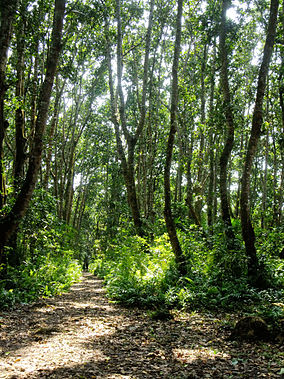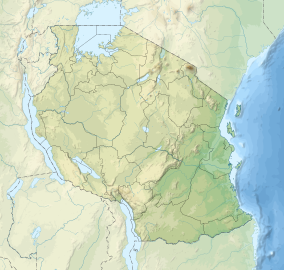Jozani-Chwaka Bay National Park
| Jozani Chwaka Bay National Park | |
|---|---|
|
IUCN category II (national park)
|
|
 |
|
|
Jozani on Zanzibar
|
|
| Location | Zanzibar, Tanzania |
| Nearest city | Jozani |
| Coordinates | 6°13′59″S 39°24′14″E / 6.233°S 39.404°ECoordinates: 6°13′59″S 39°24′14″E / 6.233°S 39.404°E |
| Area | 50 km2 (19 sq mi) |
| Established | 2004 |
| Governing body | Tanzania National Parks Authority |
The Jozani Chwaka Bay National Park is a 50 km2 (19 sq mi) national park of Tanzania located on the island of Zanzibar. It is the only national park in Zanzibar.
The Zanzibar red colobus, Procolobus kirkii (its population count is about 1000) found in the park, a rain forest species (unlike the black-and-white colobus found in other regions of Africa), is also known as Kirk's red colobus, named after Sir John Kirk (1832–1922), the British Resident of Zanzibar who had first brought it to the attention of zoological science. It is now adopted as the flagship species for conservation in Zanzibar, from the mid-1990s. Other species of fauna found in the park are the Sykes monkey, bush babies, more than 50 species of butterfly and 40 species of birds. The nocturnal Zanzibar tree hyrax, which has four ‘toes’ on its front feet and three on its back, is said to be the first hyrax species that has acclimatized to the forest. As part of the tourism circuit, the park attracts 10% of the over 100,000 visitors to Zanzibar every year. Wild life attractions of Zanzibar also include dolphins apart from deep sea fishing for tuna, marlin, and shark.
Another animal in the forests of the Unguja Island unequaled elsewhere is the Zanzibar leopard (Panthera pardus adersi). In the local legend, this reportedly extinct species, has been given a mythical status and is called 'Chui' and is part of the superstitious beliefs of the people. People believe that sorcerers keep this animal as their pet and scare people by spinning stories that the animal appears like spirits and disappears into thin air. It was last reported in 1999 and officials, and men working on the “coral rag” lands of the southern and eastern Ungula Island are assertive that the species is not extinct, though it has not been sighted since 2003. The last sighting reported in 2002-2003 was of two leopards. The photographic proof of this species is at present only in the form of a stuffed museum display in Zanzibar Museum and a few skins in museums in London and Massachusetts in the United States. A smaller leopard with spots, which is a biological product of the larger animal, is seen now in the island.
...
Wikipedia

